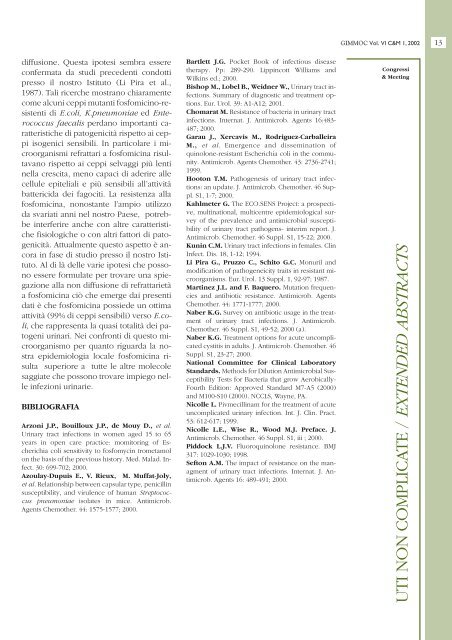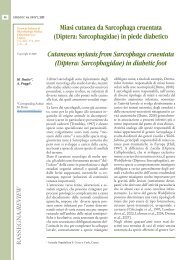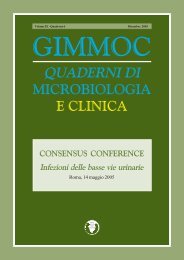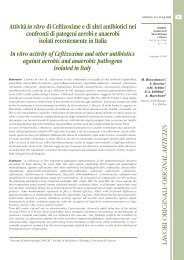Congressi & Meeting, Dicembre 2002 - Gimmoc.it
Congressi & Meeting, Dicembre 2002 - Gimmoc.it
Congressi & Meeting, Dicembre 2002 - Gimmoc.it
Create successful ePaper yourself
Turn your PDF publications into a flip-book with our unique Google optimized e-Paper software.
diffusione. Questa ipotesi sembra essere<br />
confermata da studi precedenti condotti<br />
presso il nostro Ist<strong>it</strong>uto (Li Pira et al.,<br />
1987). Tali ricerche mostrano chiaramente<br />
come alcuni ceppi mutanti fosfomicino-resistenti<br />
di E.coli, K.pneumoniae ed Enterococcus<br />
faecalis perdano importanti caratteristiche<br />
di patogenic<strong>it</strong>à rispetto ai ceppi<br />
isogenici sensibili. In particolare i microorganismi<br />
refrattari a fosfomicina risultavano<br />
rispetto ai ceppi selvaggi più lenti<br />
nella cresc<strong>it</strong>a, meno capaci di aderire alle<br />
cellule ep<strong>it</strong>eliali e più sensibili all’attiv<strong>it</strong>à<br />
battericida dei fagoc<strong>it</strong>i. La resistenza alla<br />
fosfomicina, nonostante l’ampio utilizzo<br />
da svariati anni nel nostro Paese, potrebbe<br />
interferire anche con altre caratteristiche<br />
fisiologiche o con altri fattori di patogenic<strong>it</strong>à.<br />
Attualmente questo aspetto è ancora<br />
in fase di studio presso il nostro Ist<strong>it</strong>uto.<br />
Al di là delle varie ipotesi che possono<br />
essere formulate per trovare una spiegazione<br />
alla non diffusione di refrattarietà<br />
a fosfomicina ciò che emerge dai presenti<br />
dati è che fosfomicina possiede un ottima<br />
attiv<strong>it</strong>à (99% di ceppi sensibili) verso E.coli,<br />
che rappresenta la quasi total<strong>it</strong>à dei patogeni<br />
urinari. Nei confronti di questo microorganismo<br />
per quanto riguarda la nostra<br />
epidemiologia locale fosfomicina risulta<br />
superiore a tutte le altre molecole<br />
saggiate che possono trovare impiego nelle<br />
infezioni urinarie.<br />
BIBLIOGRAFIA<br />
Arzoni J.P., Bouilloux J.P., de Mouy D., et al.<br />
Urinary tract infections in women aged 15 to 65<br />
years in open care practice: mom<strong>it</strong>oring of Escherichia<br />
coli sens<strong>it</strong>iv<strong>it</strong>y to fosfomycin trometamol<br />
on the basis of the previous history. Med. Malad. Infect.<br />
30: 699-702; 2000.<br />
Azoulay-Dupuis E., V. Rieux, M. Muffat-Joly,<br />
et al. Relationship between capsular type, penicillin<br />
susceptibil<strong>it</strong>y, and virulence of human Streptococcus<br />
pneumoniae isolates in mice. Antimicrob.<br />
Agents Chemother. 44: 1575-1577; 2000.<br />
Bartlett J.G. Pocket Book of infectious disease<br />
therapy. Pp: 289-290. Lippincott Williams and<br />
Wilkins ed.; 2000.<br />
Bishop M., Lobel B., Weidner W., Urinary tract infections.<br />
Summary of diagnostic and treatment options.<br />
Eur. Urol. 39: A1-A12; 2001.<br />
Chomarat M. Resistance of bacteria in urinary tract<br />
infections. Internat. J. Antimicrob. Agents 16:483-<br />
487; 2000.<br />
Garau J., Xercavis M., Rodriguez-Carballeira<br />
M., et al. Emergence and dissemination of<br />
quinolone-resistant Escherichia coli in the commun<strong>it</strong>y.<br />
Antimicrob. Agents Chemother. 43: 2736-2741;<br />
1999.<br />
Hooton T.M. Pathogenesis of urinary tract infections:<br />
an update. J. Antimicrob. Chemother. 46 Suppl.<br />
S1, 1-7; 2000.<br />
Kahlmeter G. The ECO.SENS Project: a prospective,<br />
multinational, multicentre epidemiological survey<br />
of the prevalence and antimicrobial susceptibil<strong>it</strong>y<br />
of urinary tract pathogens- interim report. J.<br />
Antimicrob. Chemother. 46 Suppl. S1, 15-22; 2000.<br />
Kunin C.M. Urinary tract infections in females. Clin<br />
Infect. Dis. 18, 1-12; 1994.<br />
Li Pira G., Pruzzo C., Sch<strong>it</strong>o G.C. Monuril and<br />
modification of pathogeneic<strong>it</strong>y tra<strong>it</strong>s in resistant microorganisms.<br />
Eur. Urol. 13 Suppl. 1, 92-97; 1987.<br />
Martinez J.L. and F. Baquero. Mutation frequencies<br />
and antibiotic resistance. Antimicrob. Agents<br />
Chemother. 44: 1771-1777; 2000.<br />
Naber K.G. Survey on antibiotic usage in the treatment<br />
of urinary tract infections. J. Antimicrob.<br />
Chemother. 46 Suppl. S1, 49-52; 2000 (a).<br />
Naber K.G. Treatment options for acute uncomplicated<br />
cyst<strong>it</strong>is in adults. J. Antimicrob. Chemother. 46<br />
Suppl. S1, 23-27; 2000.<br />
National Comm<strong>it</strong>tee for Clinical Laboratory<br />
Standards. Methods for Dilution Antimicrobial Susceptibil<strong>it</strong>y<br />
Tests for Bacteria that grow Aerobically-<br />
Fourth Ed<strong>it</strong>ion: Approved Standard M7-A5 (2000)<br />
and M100-S10 (2000). NCCLS, Wayne, PA.<br />
Nicolle L. Pivmecillinam for the treatment of acute<br />
uncomplicated urinary infection. Int. J. Clin. Pract.<br />
53: 612-617; 1999.<br />
Nicolle L.E., Wise R., Wood M.J. Preface. J.<br />
Antimicrob. Chemother. 46 Suppl. S1, iii ; 2000.<br />
Piddock L.J.V. Fluoroquinolone resistance. BMJ<br />
317: 1029-1030; 1998.<br />
Sefton A.M. The impact of resistance on the managment<br />
of urinary tract infections. Internat. J. Antimicrob.<br />
Agents 16: 489-491; 2000.<br />
GIMMOC Vol. VI C&M 1, <strong>2002</strong><br />
<strong>Congressi</strong><br />
& <strong>Meeting</strong><br />
UTI NON COMPLICATE / EXTENDED ABSTRACTS<br />
13






